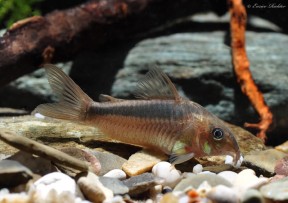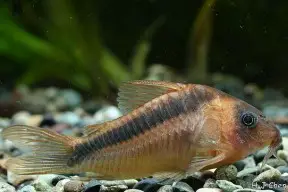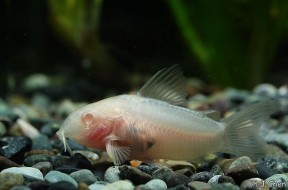Corydoras rabauti
Rusty Cory
SynonymsTop ↑
Corydoras myersi Miranda Ribeiro, 1942
Etymology
Corydoras: from the Ancient Greek κόρυς (korus), meaning ‘helmet’, and δορά (dora), meaning ‘skin, hide of an animal’, in allusion to the rows of bony plates on the flanks of genus members.
rabauti: named for Mr. Auguste Rabaut, adventurer and collector of flora and fauna.
Classification
Order: Siluriformes Family: Callichthyidae
Distribution
The majority of records pertain to the rio Javarí, an Amazonian tributary which forms the border between Brazil and Peru for much of its length and empties into the Amazon main channel in the Três Fronteiras area, where the borders of Brazil, Peru and Colombia meet. It thus seems likely that C. rabauti occurs in both Brazil and Peru, and possibly Colombia, but the full extent of its distribution is somewhat unclear.
Type locality is ‘tributary of Amazon River, 7 days by river boat from Manaus, 3°06’S, 60°00’W, Amazonas, Brazil’.
Habitat
Few details are available, but some collection records suggest that it inhabits floodplain lakes and oxbows as well as riverine habitats.
Maximum Standard Length
55 – 65 mm.
Aquarium SizeTop ↑
Minimum base dimensi0ns of 90 ∗ 30 cm are recommended.
Maintenance
Ideally use a substrate of fine sand, although rounded gravel is an acceptable alternative provided that it is kept scrupulously clean.
Other décor is largely down to personal choice, but some cover should be provided to give the fish security.
Water Conditions
Temperature: 20 – 27 °C
pH: 5.5 – 7.2
Hardness: 18 – 215 ppm
Diet
Corydoras spp. are foraging omnivores and will accept most sinking dried foods, as well as small live and frozen varieties such as chironomid larvae (bloodworm), Tubifex, etc.
Feeding a varied diet will ensure the fish are in optimum condition.
Under no circumstances should they be expected to survive on ‘left-overs’ from other inhabitants of the aquarium or relied on to ‘clean’ the aquarium.
Behaviour and CompatibilityTop ↑
Peaceful and gregarious. Should be maintained in a group of at least 4-6 individuals.
Sexual Dimorphism
Females tend to grow larger, and sexually mature individuals are noticeably broader and deeper-bodied than males.
Reproduction
Can be bred in a similar fashion to many other Corydoras species.
Use a ratio of two or more males per female if possible, and when the females are visibly full of eggs perform a large (50-70%) water change with cooler water, and increase oxygenation and flow in the tank. Repeat this daily until the fish spawn.
Eggs may be deposited on the aquarium glass, among fine-leaved vegetation or within sunken spawning mops, with the latter particularly recommended since they facilitate easy removal of eggs.
Once spawning is complete either adults or eggs should be removed; the latter can usually be rolled gently up the glass with a finger. The new container should contain the same water as the spawning tank and be similarly well-oxygenated.
Most breeders add a few drops of methylene blue, or an alder cone or two at this point in order to prevent the eggs developing fungus.
Incubation is normally 3-4 days and once the fry have fully-absorbed their yolk sacs they are able to accept small live foods such as microworm, Artemia nauplii, etc.
They are not the easiest to raise, requiring excellent water quality, but seem less susceptible to ailments when maintained over a thin layer of sand rather than in a bare arrangement.
NotesTop ↑
C. rabauti is also known as ‘Rabaut’s cory’, ‘rust cory’, and ‘iridescent cory’ in the aquarium trade. An ornamental albino form is available on occasion.
The broad dark stripe in the dorsal portion of the body extends into the ventral portion on the caudal peduncle, and this character can be used to distinguish it from the very similar-looking C. zygatus, with which it is often confused. In C. zygatus the dark stripe does not extend ventrally on the caudal peduncle and is present only on the dorsal part.
Corydoras is included in the family Callichthyidae, of which members are often referred to collectively as ‘armoured’ or ‘mailed’ catfishes group due to the presence of bony plates in place of scales on the body.
Their taxonomy can be confusing, and numerous undescribed species are also thought to exist.
Fish of unconfirmed identification entering the aquarium hobby are therefore typically assigned a ‘C‘ or ‘CW‘ number for purposes of reference and organisation.
They are facultative air breathers and possess a modified, highly vascularised intestine which has evolved to facilitate uptake of atmospheric oxygen and aid survival in oxygen-deprived environments. In the aquarium you’ll occasionally see them rising to the surface to take in gulps of air.
The stiffened pectoral-fin spines are capable of piercing human skin and a ‘sting’ can be very painful indeed, so care should be exercised when handling them.
It’s thought that secretions from the axillary glands at the base of each spine may even be mildly toxic or venomous.
References
- La Monte, F. R., 1941 - Zoologica, Scientific Contributions of the New York Zoological Society v. 26 (pt 1, no. 2): 5-6
A new Corydoras from Brazil. - Reis, R. E., S. O. Kullander and C. J. Ferraris, Jr. (eds), 2003 - EDIPUCRS, Porto Alegre: i-xi + 1-729
Check list of the freshwater fishes of South and Central America. CLOFFSCA. - Ferraris, C. J., Jr., 2007 - Zootaxa 1418: 1-628
Checklist of catfishes, recent and fossil (Osteichthyes: Siluriformes), and catalogue of siluriform primary types. - Fuller, I. A. M., and H-G. Evers, 2005 - Verlag A. C. S. GmbH: 1-384
Identifying Corydoradinae Catfish.




November 13th, 2014 at 6:38 pm
2.2″ (5.5cm), also stated on PlanetCatfish, is wrong.
I got a new group of these chaps, w/c, last Sunday, Ian Fuller confirmed them as C.Rabauti, and they are larger…. males are indeed perhaps 2.2, but females are > 2.5. I’ll get to measuring them eventually, posting this now only making sure I don’t forget.
November 14th, 2014 at 3:12 pm
Ok thanks Mike, made some modifications. 😉